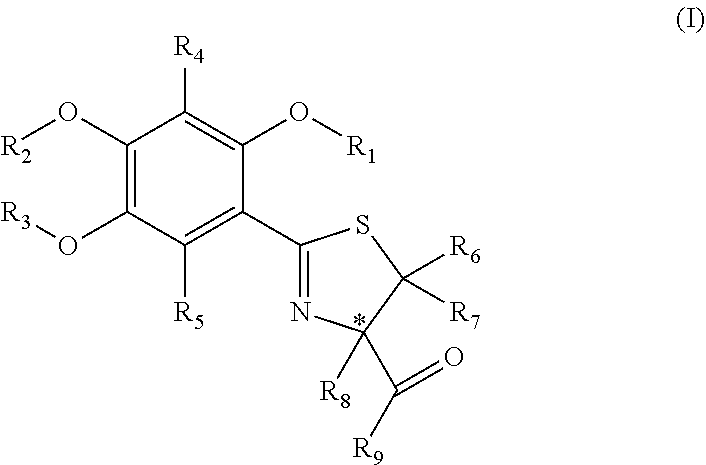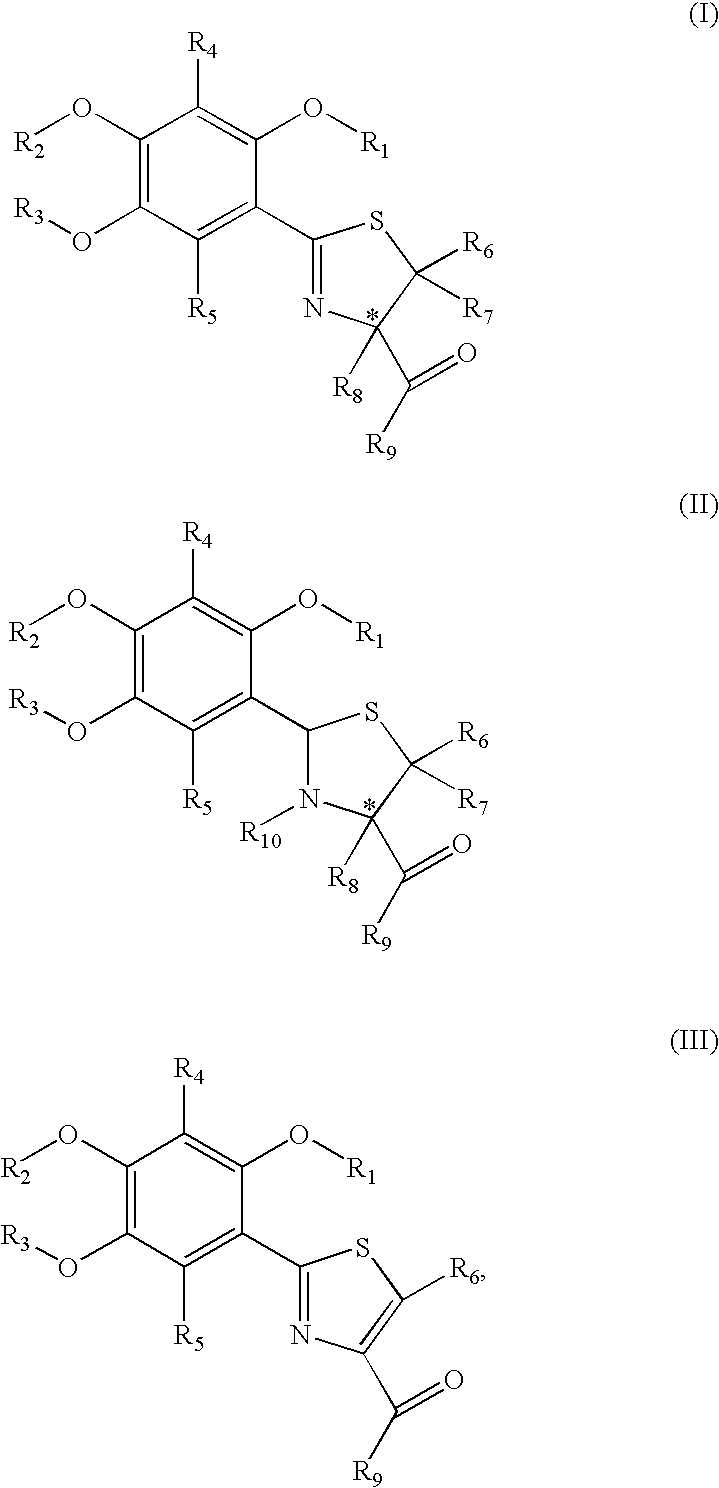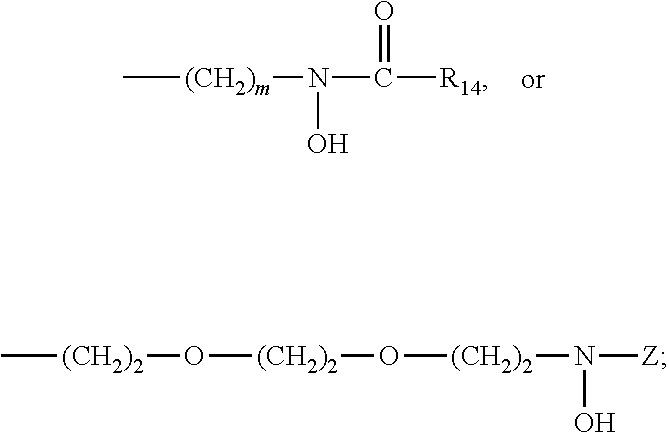Desferrithiocin derivatives and methods of use thereof
a technology of desferrithiocin and derivatives, applied in the field of desferrithiocin derivatives, can solve the problems of no specific mechanism for eliminating this transition metal, biological damage, and inability to phlebotomy, and achieve the effects of reducing oxidative stress, improving oral bioavailability, and high iron clearing efficiency
- Summary
- Abstract
- Description
- Claims
- Application Information
AI Technical Summary
Benefits of technology
Problems solved by technology
Method used
Image
Examples
example 1
Synthesis of Compounds
[0095](S)-2-(4′,5′-dimethoxyphenyl)-4-thiazoline-4-carboxylic acid (1) and (S)-2-(4′,5′-dimethoxyphenyl)-4-methylthiazoline-4-carboxylic acid (2) (also referred to as (S)-4′,5′-dimethoxydesazadesmethyldesferrithiocin and (S)-4′,5′-dimethoxydesazadesferrithiocin, respectively) were prepared starting with 2-benzyloxy-4,5-dimethoxybenzaldehyde (6), which was converted to the corresponding oxime by reacting 6 with hydroxylamine hydrochloride and triethylamine in acetonitrile at about 50° C. for about 18 hours. The corresponding nitrile (7) was prepared from the oxime by refluxing the intermediate product with phthalic anhydride for 1 day to give nitrile 7 in 87% yield. Nitrile 7 was reacted with hydrogen on a Pd—C catalyst in an ethanol / ethyl acetate mixture for about 50 minutes to remove the O-benzyl group and form 4,5-dimethoxy-2-hydroxybenzonitrile (8) in 84% yield. The deprotected nitrile 8 was subsequently reacted with D-cysteine or D-alpha-methylcysteine in a...
example 2
Iron Clearance in Cebus apella Monkeys
[0098](S)-2-(4′,5′-dimethoxyphenyl)-4-methylthiazoline-4-carboxylic acid (2) was administered to iron-overloaded Cebus apella monkeys. The protocol can be found in Bergeron, R. J. et al., “Methoxylatoin of Desazadesferrithiocin Analogues: Enhanced Iron Clearing Efficiency,”J Med Chem. 46:1470-1477 (2003), the contents of which are incorporated herein by reference. Briefly, the monkeys were iron overloaded with iron dextran administered intravenously to result in an iron loading of about 500 mg per kg of body weight. At least 20 half-lives, 60 days, elapsed before the animals were used in experiments evaluating iron chelators. The iron chelator was solubilized in 40% Cremophor RH-40 / water (v / v) and were administered orally to the monkeys. Fecal and urine samples were collected at 24 hour intervals beginning 4 days prior to the administration of an iron chelator and continued for 5 days after the chelator was administered. Iron concentrations in s...
example 3
Iron Clearance in Rats
[0100](S)-2-(4′,5′-dimethoxyphenyl)-4-thiazoline-4-carboxylic acid (1) was administered to non-iron overloaded, fasted rats that had been subjected to routine bile duct cannulation. Briefly, male Sprague-Dawley rats averaging 450 g were housed in Nalgene plastic metabolic cages during the experimental period and given free access to water. The animals were anesthetized using sodium pentobarbital (55 mg / kg) administered intraperitoneally. The bile duct was cannulated using 22-gauge polyethylene tubing. The cannula was inserted into the duct about 1 cm from the duodenum and tied snugly in place. After threading through the shoulder, the cannula was passed from the rat to the swivel inside a metal torque-transmitting tether, which was attached to a rodent jacket around the animal's chest. The cannula was directed from the rat to a Gilson microfraction collector (Middleton, Wis.) by a fluid swivel mounted above the metabolic cage. Bile samples were collected at 3 h...
PUM
| Property | Measurement | Unit |
|---|---|---|
| enantiomeric excess | aaaaa | aaaaa |
| enantiomeric excess | aaaaa | aaaaa |
| enantiomeric excess | aaaaa | aaaaa |
Abstract
Description
Claims
Application Information
 Login to View More
Login to View More - R&D
- Intellectual Property
- Life Sciences
- Materials
- Tech Scout
- Unparalleled Data Quality
- Higher Quality Content
- 60% Fewer Hallucinations
Browse by: Latest US Patents, China's latest patents, Technical Efficacy Thesaurus, Application Domain, Technology Topic, Popular Technical Reports.
© 2025 PatSnap. All rights reserved.Legal|Privacy policy|Modern Slavery Act Transparency Statement|Sitemap|About US| Contact US: help@patsnap.com



